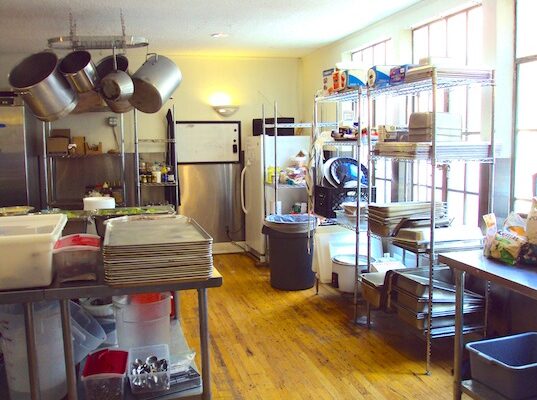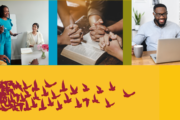When Pastor Ed Carey arrived at Hope International Bible Fellowship (Hope IBF) in 1994, the situation was grim. The once-thriving congregation was down to 30 people and thinking of closing its doors. The church building was starting to show its age after nearly 75 years of service, the congregation’s debt seemed insurmountable and the surrounding neighborhood was developing a reputation as a place of poverty, crime and vice.
Many members had already spoken with their feet—almost all of them had left the church—but Pastor Carey sensed something at Hope IBF that others did not. He saw life in the congregation and the church building, and he saw life in the surrounding East Hollywood neighborhood. Pastor Carey decided to stay, but his plan to change the trajectory of Hope IBF did not involve trying to convince people to drive in from the suburbs or recruiting people who “had it all together” to join the church. Instead, less than a year after he arrived Pastor Carey started a recovery program at Hope IBF and invited people struggling with addiction to join the church.
A recovering alcoholic himself, Pastor Carey didn’t view people with drug and alcohol problems as liabilities who would drain the church’s meager resources; rather, he saw them as spiritual assets who could be “repurposed” to help rebuild the church. In other words, he could see the life in them too.
We saw the fruits of Pastor Carey’s work when we visited Hope IBF to take a tour of the Manna Room, the church’s food ministry. Ben Falcioni, the director of the Manna Room, showed us the former Sunday school space at Hope IBF that had been converted into a refrigerated food-storage area to hold the bulk of the 4,000 pounds of donated food collected each day. The Manna Room partners with local Trader Joe’s and Whole Foods stores to collect food that is about to expire or that is no longer useful to the stores. Ten percent of the food is used for the two daily meals that are prepared in Hope IBF’s kitchen and served to locals who could use a hot meal. The other 90 percent of the food is distributed to small, community-based ministries and charities in Los Angeles. Using food that others have deemed useless, the Manna Room works with others to make 400,000 meals a year for people in need.
“I tell the guys in our recovery program that they are like these vegetables,” Falcioni said. “They come here bruised, battered and have been thrown out as trash. But there is still life in them.”
The Manna Room is a labor-intensive operation that requires dozens of people to drive the delivery trucks, sort the food, prepare the meals, maintain community relationships and clean the kitchen at the end of each day. Falcioni is the only paid staff member, so the lifeblood of the operation are the volunteers.
Most and sometimes all of the Manna Room’s volunteers are currently participating in IBF’s recovery program. Many of them show up at the church during some of the lowest points of their lives—in fact, some are close to their own expiration dates. They have hurt themselves as well as the people closest to them, and arrive needing serious help. When they reach Hope IBF’s doorstep, helping others may be the last thing on their minds, but serving others who are also in need is an integral part of the recovery program.
Participants live in Hope IBF-owned housing and wake up at 4am to pick up the food, salvage what is edible, then clean and prepare it to be served for the free morning and afternoon meals. Their service to the church is as essential to their recovery as the 12-steps themselves.
On any given weekday, there are dozens of people working in the kitchen and dozens more eating a free meal in the church’s ad hoc dining room. During the weekend, hundreds more people enter the building as members of the five separate congregations that worship at Hope’s sanctuary. Latino, Armenian and Roma congregations, along with two groups aimed at the twenty-something hipsters now moving into the neighborhood, rent the sanctuary to hold worship services. These six very diverse congregations hold periodic barbeques together, and some members of the other groups participate as volunteers at the Manna Room.
The monthly rents from these congregations, along with additional support from mission teams from around the country, pay for things like the $40,000 in gas that IBF’s delivery trucks consumer each year. Seeing the bustling daily activity at IBF in 2014 makes it hard to imagine that 20 years ago, the church was struggling just to keep its doors open.
In some ways, Hope IBF looks a lot like the Jesus People Movement of the 1960’s. Larry Eskridge, a historian at Wheaton College, argues that, “Far from being an ephemeral blip or a religious fad, the Jesus People Movement was a major episode in American religious history.” Like the Jesus People, Hope IBF embodies the informality of the early church, embraces a counter-cultural identity and attracts people who are drawn to a faith practice that they perceive as authentic. But even though it shares the spirit of an American movement from an earlier era, Hope IBF is a unique and innovative place whose mission and programming have been shaped foremost by the vision of Pastor Carey.
Hope IBF is a reflection of its pastor because the church and its ministries see the life—not the imperfections—in the surrounding neighborhood, the church building, the food donated daily and the people who pass through its doors.
Andrew Johnson is a contributing fellow with the USC Center for Religion and Civic Culture.







